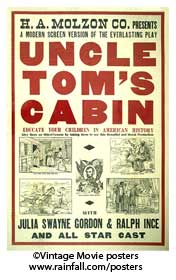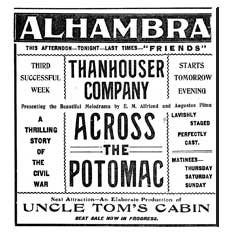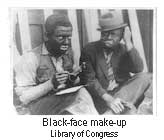The history of blacks in film can be defined by the evolution of the characters. In 1903, blacks were played by whites in black face. By the roaring 20’s, the movie industry had shifted allowing blacks to appear in movies – but only as comic relief. In the 30’s, black actors appeared as field hands or servants. The 1940s found still another shift – the black entertainer. Finally in 1950, we saw real character development.

Uncle Tom’s Cabin or Slavery Days, 13 min., 1903, was made by the Thomas Edison Company, Edwin Porter, director. A full length movie was about 14 minutes in 1903. The movie was shot in a studio relying heavily on a set from a typical “Tom show.” White actors in black face had the major “black” parts – with blacks acting only as extras. Even at the depiction of a slave auction, the blacks couldn’t help dancing. The action suggests that both the studio and the viewers believed this to be historically accurate. Other movies had black-faced white actors with overdone make-up playing the parts of ‘good’ Negro, a black buffoon, a mammy or a large black aggressive male not knowing his rank in society.
By the roaring 20’s, the movies headed towards a feeling of greater authenticity. Blacks began to get roles. Mathew Beard had the role of Stymie in the “Our Gang” series. He got that name because the director, Robert McGowan, claimed that Beard always “stymied” (unintentionally frustrated) him on every take. Mathew Beard said about his “Our Gang” portrayal: “We knew even then that ‘Stymie’ was an insult to our race, but it was the depression and I had seven sisters and six brothers at home.”
By 1930, the roles for blacks had shifted to servants, field hands or mammies. In Old Kentucky, 1935, Bill ‘Bojangles’ Robinson shows some breathtaking footwork. In a great scene he teaches Will Rogers how to tap dance. There is more than a little racism in the story, typical of Hollywood films of the era. It was the last film that Will Rogers was in – he died shortly thereafter in a plane crash. Again we find ‘Bojangles’ in Little Colonel, 1935, playing the part of Shirley Temple’s trusted servant. In Gone with the Wind, 1939, we see Hattie McDaniel play the part of Mammy, a pivotal part in the movie. In Showboat, 1935, we see Paul Robeson as Joe, the field hand, loading cotton.

Feel the rhythm of the 30’s. Stepin Fetchit (Lincoln Perry) was born in 1902, 1896 or 1998 depending on which source you read. He took his stage name from his favorite race horse. In the movies he was a subservient, bug-eyed, slow shuffling, dim-witted black. With a vaudeville background, he had superb timing and comic talent. His name became synonymous with degrading portrayals of blacks. At the start of his career, the civil rights groups complained about the stereotyped image. Later he received accolades for his part in opening doors for black actors. He was awarded the Special Image Award by the NAACP. And elected to the Black Filmmaker’s Hall of Fame in 1978. He was the first black actor to become a millionaire, a star in his own right. He was signed by Fox films – featured alongside other stars such as Will Rogers. At the height of his career, he had 12 cars and 16 servants, but was bankrupt by 1947… fortune squandered. His work is rarely seen today, often edited out of TV prints – hardly fair. Get past the “historic baggage” and find a highly competent actor with great comic timing and talent. He cared about his work, suing CBS in 1970 after the network showed clips of his films out of context. History has been twisted. He was slammed for taking the only roles open.
The 1940s saw another shift with black entertainers appearing in films. Duke Ellington, Louis Armstrong, Count Basie, etc. appeared in white movies mostly to entertain. The jazz was hot. The pre-war comedy (Going Places, 1938) of manners at the race track had Louis Armstrong singing “Jeepers Creepers.” The casual acceptance of denigration of blacks is reflected by two race track gamblers addressing Armstrong as Uncle Tom when they meet him.
In The Cabin in the Sky, 1949, Armstrong played the part of the trumpeter. The speaking parts were small. The women were slender, fair skinned and usually singing scat tunes or love ballads. A scat tune was a song without lyrics – doo doo doo waw! Blacks were allowed to have a family onscreen that resembled mainstream America. They were close but not quite equal to their white counterparts.

Pinky, 1949, was a revolution with a screenplay that told a story of racial conflicts and treatment. Pinky was a light skinned black. She passed for a white in a Northern nursing school. Returning to the South, she fell in love with a white doctor who knew nothing about her black heritage. Ironically, Pinky was played by a white starlet, Jeanne Crain. Evelyn gets special mention as a vicious Southern matron. The director, Elia Kazan, is out of style because he named names in the McCarthy witch-hunts. His brilliant talents as a director show in this film. He had the courage to tackle racial prejudice head-on. In Gentleman’s Agreement, he directed a movie showing a deeply prejudiced South where black girls were attacked on the streets. Shops refuse them service – strong language.
The 1950s changed the black character in ways never before possible. Black actors emerged as stars. The roles became more sympathetic to the black race. Hollywood shifts with the color green. There was profit to be made. With more money spent on black film, stars such as Sidney Poitier, Dorothy Dandridge and Nat King Cole emerged. The movies shifted towards drama with anything possible for black roles in this era. The new films shouted for social change and hit new comedic direction. Take a look at No Way Out, 1950, or Cry Beloved Country, 1951, to see Sidney Poitier in action, climaxing with him being the first male black actor to get an Oscar for Lillies in the Field, 1963.
If Stepin Fetchit had tried to be the hero, kiss the girl, ride off into the sunset, the studio would have laughed at him – tossed him out the door. He took the part of the bug-eyed black comic, instead – and made a million dollars…real money in the 1930’s. Stymie acted in Our Gang because they needed the money – depression days. Hattie McDaniel used the side door at the studios – got the parts. The early actors opened windows for the next – not a bad legacy.
The original print of Uncle Tom’s Cabin is in the Library of Congress.
Editors note
